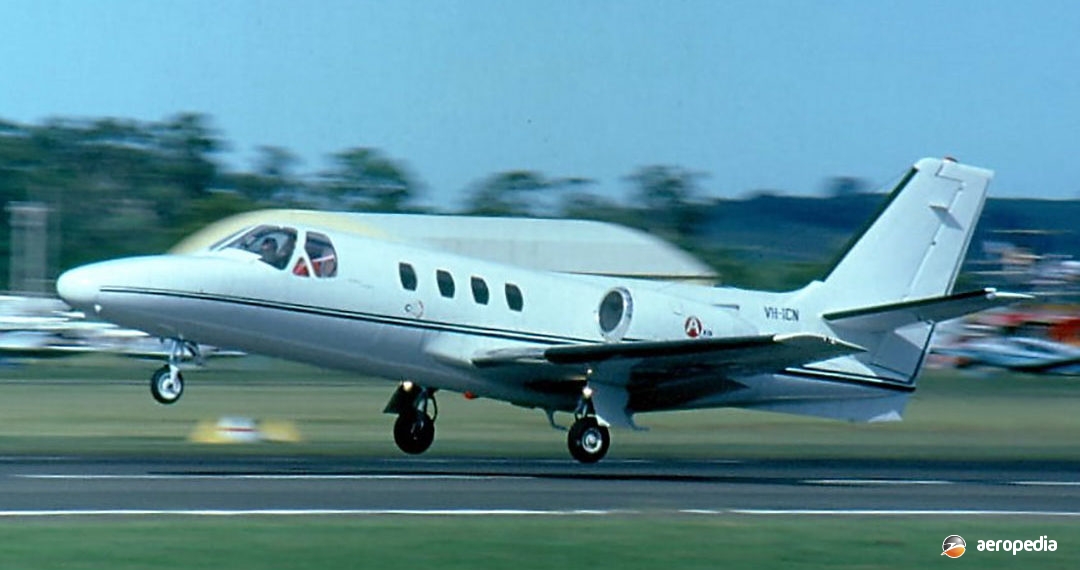Photograph:
Cessna 500 Citation VH-ICN (c/n 500-0024) at Bankstown, NSW (David C Eyre)
Country of origin:
United States of America
Description:
Business and executive aircraft
Power Plant:
Two 2,200 lbst Pratt & Whitney of Canada JT15D-1A turbofans
Specifications:
- Wingspan: 14.36 m (47 ft 1 in)
- Length: 13.27 m (43 ft 6 in)
- Height: 4.37 m (14 ft 4 in)
- Wing area: 24.2 m² (260 sq ft)
- Max cruising speed: 650 km/h (404 mph)
- Initial rate of climb: 817 m/min (2,680 ft/min)
- Max certificated altitude: 12,505 m (41,000 ft)
- Range with six passengers and 45 mins reserve: 2,470 km (1,535 miles)
- Empty weight: 2,932 kg (6,464 lb)
- Loaded weight: 5,828 kg (12,850 lb)
History:
On 7 October 1968 Cessna unveiled a full-scale mock-up of a new eight-seat pressurised executive jet aircraft, known as the Fanjet 500, to delegates at that year’s National Business Aircraft Association Convention (NBAA) at Houston, Texas. The aircraft was designed to be operated from most airfields used by light and medium twin-engined aircraft, ie 762 m (2,500 ft) in length, and deliveries of production aircraft were scheduled to begin in January 1972, to be certificated to FAR Pt 25 for transport category aircraft.
The prototype (N500CC) flew on 15 September 1969, at which time it became known as the Citation. It was a cantilever low-wing monoplane without sweepback, the wing having two primary spars, an auxiliary spar, three fuselage attachment points and conventional ribs and stringers. It had electrically-operated flaps and aerodynamic speed brakes. The fuselage was an all-metal pressurised structure of circular section.
Following its introduction in 1971 by Cessna, then the world’s largest producer of light civil aircraft, the Citation proved to be the fastest selling of the biz-jets. Progressive refinements to the aircraft throughout its production life led to a range of aircraft to meet customer requirements.
The first aircraft in the series was the Model 500, which could accommodate six to eight persons, with an initial gross weight of 4,695 kg (10,350 lb), which was later increased to 5,216 kg (11,500 lb). Powered by two Pratt & Whitney of Canada JT15-D1 turbofans, this aircraft cruised at 644 km/h (400 mph) for a range of 4,667 km (2,900 miles). Some re-design was necessary before it entered production, certification being received on 9 September 1971.
Next model in the range was the Citation I, which was similar to the earlier aircraft, with the Pratt & Whitney JT15D-1A engines of 2,200 lbst, and an increase in all-up weight to 5,375 kg (11,850 lb). The Citation I/SP was a variant catering specifically for single-pilot operation. Some 690 examples of these models were constructed before production ceased in 1985.
Cessna began deliveries of its first business jet, the Citation 500, in 1972. The 1,000th of its business jets, a Citation II, was delivered in 1982. It delivered its 3,000th business jet in 2003 and maintained a production rate of more than 100 aircraft per year.
Examples which have operated in this region over the years have included: Citation VH-ICN (c/n 500-0024) from April 1990 to January 1997 when it was exported as N94AJ; VH-ICX (c/n 500-0051) from January 1990 to February 1997 when it became VH-EMM; VH-DRM (c/n 500-0112) from April 1974 to September 1975 when it was exported as N3LG; VH-CRM from November 1973 to September 1974 when it was exported as N4LG; VH-UCC (c/n 500-0142) from January 1975 to April 1981 when it was exported as N650TF; VH-WRM (c/n 500-0150) from May 1974 to September 1975 when it was exported as N5LG; VH-LGL (c/n 500-0206) from February 1990 to November 1992 when it was exported as N771HR; and VH-FSQ (c/n 500-0225) from April 1984 to January 1987 when it became VH-OIL, being exported in September 1992 as RP-C-1500.
VH-FSA (c/n 500-0237) was registered from January 1984 to 16 February 1984 when it crashed at Proserpine, QLD; VH-AQR (c/n 500-0263) from November 1993 when it became VH-AQS, becoming VH-ZMD with Australasian Jet Pty Ltd in February 1994; VH-NEW (c/n 500-0268) from September 1984 to May 1991 when it was exported as A6-RKH; VH-NMW (c/n 500-0279) from August 1991 to December 1994 when it was exported as N120S; VH-ANQ (c/n 500-0283) from May 1986 to 11 May 1990 when it crashed at Mt Emerald, QLD; VH-SOU (c/n 500-0333) from August 1997, operated by Sydney Jet Charter; and VH-HVM (c/n 500-0349) from February 1989 to August 2001 when it became VH-HVH with Sterling Aviation Pty Ltd.
Examples of the variant known as the Citation Eagle have included: VH-HKX (c/n 500-0050) from February 1988 with Metropolis City Promotions; VH-LJL (c/n 500-0123) from December 1990 to March 1994 when it became ZK-LJL, later becoming VH-ECD in December 1998 and being exported to South Africa as ZS-PMA in March 2003.
An example of the Citation I was registered VH-SWC (c/n 500-0394 from June 1979 to February 1986 when it was exported as N32DA.
Examples of the Citation I/SP have included: VH-POZ (c/n501-0010) from October 1983 to July 1987 when it was exported as EC-EDN; VH-LJG (c/n501-0089) from September 1999 to March 2004 when it became VH-CCJ with CCJ Pty Ltd of Brisbane, QLD; VH-LCL (c/n501-0145) from December 1988 to 22 April 1990 when it was badly damaged in an accident at Lord Howe Island, repaired and exported in September 1990 as N2652Z; and VH-BNK (c/n 501-0171) from March 1981 to April 1998 when it was exported as N171WJ.

